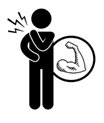PROVOKE PAIN TO GET RID OF IT?
“Should exercise be painful or not?” This is a popular question among both physiotherapists and patients, which is still looking for an answer.
The elephant in the room

If exercise is a proven effective treatment in chronic disorders concerning the human muscular and skeletal system, the level of pain during exercise is an important question. However, there are no clear indications in the literature about the level of pain which should be experienced during or after exercise. So, it remains the “elephant in the room”, an English idiom to say that a known or obvious topic remains unanswered because it is quite controversial, and people don’t want to talk about it.(1)
Pain-monitoring model
A pain monitoring model is often used during exercise, which describes a scale from 0 to 10, where 0 is indicating “no pain” and 10 is indicating “worst imaginable pain”.(2) Pain between 0 and 2 is considered “safe”, between 2 and 5 is “acceptable” and above 5 is “high risk”. Moreover, the pain is allowed to reach 5 after exercise but it should decrease by the next morning. These are general guidelines which have been differently applied in research, with various indications in the case of shoulder rehabilitation.(3-5)
What are the physiotherapists currently doing?
The lack of clear evidence-based guidelines reflects also on the current clinical practice in the rehabilitation of the so-called “rotator cuff related shoulder pain”, which happens when you get pain rotating your arm away from your body or moving it forward. A survey on the management of this shoulder disorder was distributed in four countries (United Kingdom, Belgium and The Netherlands, Italy)(6-8) and it found different results on the instructions about pain during exercise given by the physiotherapists. The most frequent answers were going from “no pain” to “acceptable pain” or depending on the “post-exercise response”. However, recent studies challenge this belief and suggest that painful exercises are better than pain-free exercises in short-term in chronic pain concerning your muscular and skeletal system.(9)
Hurt ≠ Harm
Physiotherapists usually don’t encourage patients to train into pain, which can in fact seem contradictory, since patients expect the pain to go away after treatment. However, there is no strong scientific basis to this fear and “exercising into pain” might have bigger benefits in chronic complaints. Temporary reproduction of symptoms might be allowed, following the principle that “hurt does not equal harm”.(9, 10) Considering that pain does not always indicate tissue damage (such as a tear or tendon degeneration), other factors such as fear of movement play an important role in the development and maintaining of chronic pain. When pain in the shoulder region is chronic, an altered processing of pain at higher levels in your brain might be present. If painful exercises are allowed with suitable “safety-cues”, the physiotherapist can reduce gradually the threat perception of the painful movement.(11) If the shoulder is deemed as “de-conditioned” and the purpose is to strengthen the shoulder muscles, the patients will re-think and re-program the faulty movement under the guidance of the treating physiotherapist.
No pain, no gain?

We know from the literature that painful exercises have usually higher loads or dose of exercises.(9) We also know that higher dose of exercise might give bigger benefits.(12) So, is a painful exercise program better than pain-free exercises? Are higher loads used in “exercise into pain” going to challenge the patient enough in order to gain greater strength and decrease the pain at the end of the therapy? Is it actually feasible to exercise into pain and if so, which exercises should be given?
These are some of the questions that I am trying to answer in my doctorate! Do you have more questions or are you interested in my research? You can contact me at claudia.cavaggion@uantwerpen.be or follow me on Twitter @ClaudiaCavag.
Images: “arm” icon by hunotika, “shoulder pain” icon by Gan Khoon Lay from the Noun Project
References
1. Smith BE, Riel H, Vicenzino B, Littlewood C. Elephant in the room: how much pain is ok? If physiotherapy exercise RCTs do not report it, we will never answer the question. Br J Sports Med. 2020;54(14):821-2.
2. Thomee R. A comprehensive treatment approach for patellofemoral pain syndrome in young women. Phys Ther. 1997;77(12):1690-703.
3. Holmgren T, Bjornsson Hallgren H, Oberg B, Adolfsson L, Johansson K. Effect of specific exercise strategy on need for surgery in patients with subacromial impingement syndrome: randomised controlled study. BMJ. 2012;344:e787.
4. Maenhout AG, Mahieu NN, De Muynck M, De Wilde LF, Cools AM. Does adding heavy load eccentric training to rehabilitation of patients with unilateral subacromial impingement result in better outcome? A randomized, clinical trial. Knee Surg Sports Traumatol Arthrosc. 2013;21(5):1158-67.
5. Valles-Carrascosa E, Gallego-Izquierdo T, Jimenez-Rejano JJ, Plaza-Manzano G, Pecos-Martin D, Hita-Contreras F et al. Pain, motion and function comparison of two exercise protocols for the rotator cuff and scapular stabilizers in patients with subacromial syndrome. J Hand Ther. 2018;31(2):227-37.
6. Bury J, Littlewood C. Rotator cuff disorders: a survey of current (2016) UK physiotherapy practice. Shoulder Elbow. 2018;10(1):52-61.
7. Pieters L, Voogt L, Bury J, Littlewood C, Feijen S, Cavaggion C et al. Rotator CUFF disorders: A survey of current physiotherapy practice in Belgium and the Netherlands. Musculoskelet Sci Pract. 2019;43:45-51.
8. Brindisino F, Matteuzzi I, Bury J, McCreesh K, Littlewood C. Rotator cuff disorders: A survey of current (2018) Italian physiotherapy practice. Physiother Pract Res. 2020;41(1):11-22.
9. Smith BE, Hendrick P, Smith TO, Bateman M, Moffatt F, Rathleff MS et al. Should exercises be painful in the management of chronic musculoskeletal pain? A systematic review and meta-analysis. Br J Sports Med. 2017;51(23):1679-87.
10. Littlewood C, Malliaras P, Bateman M, Stace R, May S, Walters S. The central nervous system--an additional consideration in 'rotator cuff tendinopathy' and a potential basis for understanding response to loaded therapeutic exercise. Man Ther. 2013;18(6):468-72.
11. Smith BE, Hendrick P, Bateman M, Holden S, Littlewood C, Smith TO et al. Musculoskeletal pain and exercise-challenging existing paradigms and introducing new. Br J Sports Med. 2019;53(14):907-12.
12. Littlewood C, Malliaras P, Chance-Larsen K. Therapeutic exercise for rotator cuff tendinopathy: a systematic review of contextual factors and prescription parameters. Int J Rehabil Res. 2015;38(2):95-106.